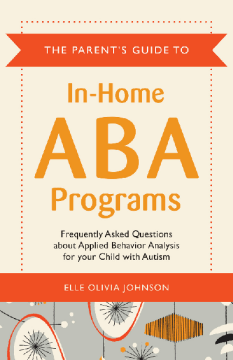
Additional Information
Book Details
Abstract
What is Applied Behavior Analysis? What will happen when an ABA therapist comes into my home? Most importantly, how can ABA help my child? This quick guide answers all of the common questions that parents have when beginning an in-home ABA program.
ABA is an effective intervention for children with autism and other developmental disorders, but all of the data collection, reinforcement, and strange lingo can be confusing for parents who are not familiar with ABA therapy. Concise and practical, this handbook explains the ins and outs of Applied Behavior Analysis in a chatty question and answer format addressing everything parents need to know from what a typical session will entail, to how to navigate their relationship with their therapist, to how to get more involved and begin using ABA methods themselves.
This book is an ideal introduction for parents to help them understand and get the most out of their child's ABA treatment. It will also be a useful resource for newly-qualified ABA therapists and for ABA agencies to use with clients.
Elle Olivia Johnson is a Specialized Academic Instruction Teacher (SAI) working with children with autism. She provides classroom-based ABA therapy, as well as in-home intensive ABA therapy. She has extensive experience with parent training, designing behavior interventions, and teaching family and staff behaviour change strategies. She has a Bachelor of Science Degree from Southern Utah University and a Master of Arts Degree in Teaching, specializing in ABA, from National University, San Diego. She resides in San Diego, California.
In this compact and helpful offering, specialized academic instruction teacher Johnson presents an introductory guide to help parents understand what ABA is, how such a program will function in your home, what ABA sessions consist of, and how parents can get the most out of ABA therapy. The book is arranged in Q&A format, with simple questions and helpful single-paragraph responses. Running the gamut from understanding visual schedules to A-B-C charts (antecedents, behaviors, and consequences), Johnson's practical guide has just enough insight and information to get a program off to a great start. VERDICT: This should be required reading for any familiy embarking on an ABA program and is a commendable addition to the literature....Enthusiastically recommended.
Library Journal (starred review)
The Parent's Guide to In-Home ABA Programs is a unique and very helpful new book that is long over-due. Reading this book will give parents a much better idea of what to expect as they embark upon ABA home programming. Besides introducing us to basic ABA principles and practices, Elle Olivia Johnson answers many questions parents frequently ask. She also raises and answers several important questions that we might never think to ask in advance about situations that could easily arise once the program gets under way. Elle shares her years of valuable experience as a knowledgeable ABA practitioner with us. Employing examples from daily life that most of us can relate to easily, she clearly explains difficult topics. Reading this book is like having a conversation with an expert and getting great advice from a good friend who has already been through an ABA home program.
Dr Albert J. Kearney, PhD, clinical and school psychologist, and author of Understanding Applied Behavior Analysis: An Introduction to ABA for Parents, Teachers, and other Professionals
Early on, as a mother of an autistic child and new to ABA programs, I had many questions and had to look for pieces of information here and there to solve the puzzle. I wish this book had been available to me sooner as it has all the answers I needed within one cover. I use it as my main reference now.
Juliet Marovich, parent of a child with autism
“The Parent's Guide to In-Home ABA Programs is a must read for anyone that is new to the ABA world. The author does a great job at providing example scenarios applicable to the real world. The language used is simple and basic, and allows the reader to fully gain an understanding of ABA without being overwhelmed. In addition, the author provides answers to all the questions that are going through your mind. By the end of this book, you will feel knowledgeable and comfortable in the world of ABA.”
Lindsay Hilsen, MEd, BCBA, Autism Clinical Educator and author of A Step-by-Step Curriculum for Early Learners with Autism Spectrum Disorder and A Step-by-Step ABA Curriculum for Young Learners with Autism Spectrum Disorders (Age 3-10)
